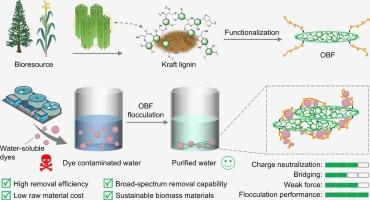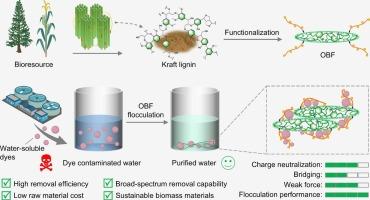高效含染料废水处理:一种更有效的絮凝剂结构和絮凝机理
IF 4.3
2区 工程技术
Q2 ENGINEERING, CHEMICAL
引用次数: 0
摘要
由于有机染料的高溶解度和传统絮凝剂的局限性,包括高投加量和残留的化学污染,对含染料废水(DCW)的处理提出了重大挑战。本研究介绍了一种章鱼状生物基絮凝剂(OBF),该絮凝剂具有分子设计的多支聚合物结构,可用于超高效地修复DCW。OBF的创新设计,具有阳离子“触须”和基于木质素的“头部”,能够实现协同作用,以比传统混凝剂(例如PAC, FeCl3)低60 - 80% %的剂量去除99% %的活性、酸性和直接染料。在实际的DCW中,OBF的性能始终优于传统混凝剂,一步即可达到严格的水质标准。OBF的成本仅为每吨0.90美元,提供了可持续且经济高效的解决方案。阳离子“触须”与木质素“头”之间的协同作用增强了其对可溶性染料的亲和力,而木质素核心的弱相互作用力促进了有效的传质。这种双重机制显著改善了染料分离和污泥脱水,降低了污泥含水量。这项工作提出了一种可持续的、可扩展的、高性能的方法来处理DCW,通过创新的分子设计推进化学工程。本文章由计算机程序翻译,如有差异,请以英文原文为准。


Efficient dye-containing wastewater treatment: a more effective flocculant structure and flocculation mechanism
Dye-containing wastewater (DCW) poses significant treatment challenges due to the high solubility of organic dyes and the limitations of conventional flocculants, including high dosage requirements and residual chemical pollution. This study introduces an octopus-like biomass-based flocculant (OBF) with a molecularly designed, multi-branched polymer architecture for ultra-efficient remediation of DCW. The innovative design of OBF, featuring cationic “tentacles” and a lignin-based “head,” enables synergistic interactions that achieve >99 % removal of reactive, acidic, and direct dyes at 60–80 % lower dosages than conventional coagulants (e.g., PAC, FeCl3). In real DCW, OBF consistently outperforms conventional coagulants, meeting stringent water quality standards in a single step. Costing only 0.90 USD per ton, OBF offers a sustainable and cost-effective solution. The synergistic interaction between cationic “tentacles” and lignin-based “head” enhances its affinity for soluble dyes, while weak interaction forces from the lignin core promote efficient mass transfer. This dual mechanism significantly improves dye separation and sludge dewatering, reducing sludge water content. This work presents a sustainable, scalable, and high-performance approach to DCW treatment, advancing chemical engineering through innovative molecular design.
求助全文
通过发布文献求助,成功后即可免费获取论文全文。
去求助
来源期刊

Chemical Engineering Science
工程技术-工程:化工
CiteScore
7.50
自引率
8.50%
发文量
1025
审稿时长
50 days
期刊介绍:
Chemical engineering enables the transformation of natural resources and energy into useful products for society. It draws on and applies natural sciences, mathematics and economics, and has developed fundamental engineering science that underpins the discipline.
Chemical Engineering Science (CES) has been publishing papers on the fundamentals of chemical engineering since 1951. CES is the platform where the most significant advances in the discipline have ever since been published. Chemical Engineering Science has accompanied and sustained chemical engineering through its development into the vibrant and broad scientific discipline it is today.
 求助内容:
求助内容: 应助结果提醒方式:
应助结果提醒方式:


